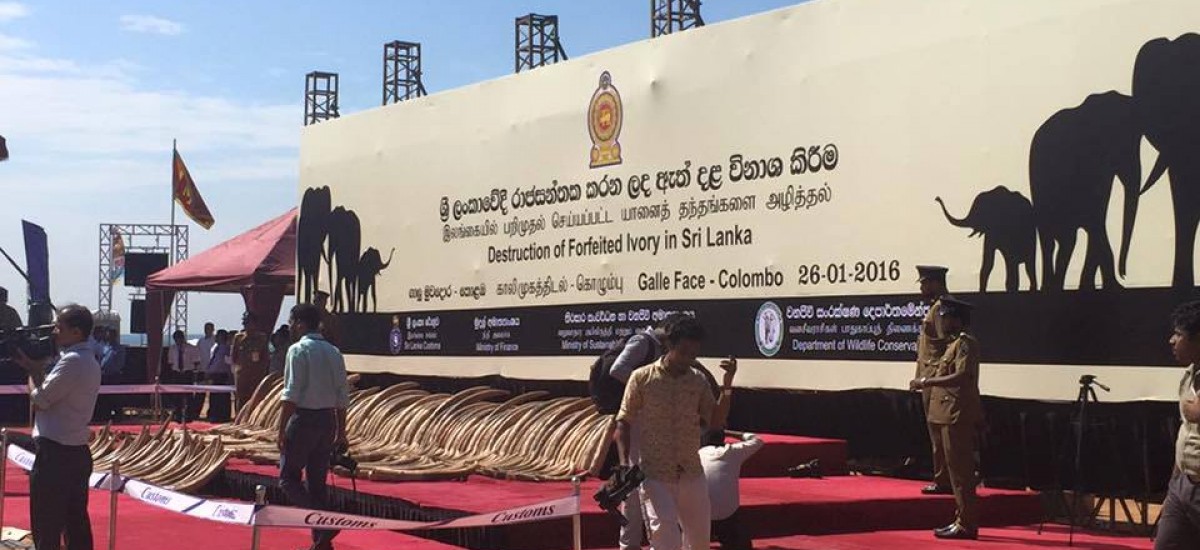Photo courtesy A Voice for Wildlife
Over 25 million elephants in Africa have succumbed to the now illegal ivory trade that has spanned across the last 200 years. To put that into perspective, that’s a little over the entire human population of Sri Lanka (21 million), wiped out in less than two centuries. We are today left with only less than one million surviving African elephants.
In 1989, the first international commercial ivory ban was enforced together with CITES (Convention on International Trade in Endangered Species). Daniel arap Moi, the Kenyan President at the time, publicly burnt 12 tonnes of ivory, putting them beyond economic use, in a gesture to persuade the world to halt the ivory trade. This was a turning point in the history of blood ivory trade that resulted in the African elephant population rebounding in a decade from 600,000 to one million. However, we still see about 50,000 elephants killed each year and their tusks being sold in illegal trade.
Other Kenyan Presidents followed suit in 2011and 2015 by destroying stockpiles of blood ivory, with 2016 about to witness the burning of the largest ivory stockpile (120 tonnes) in Kenya at a star-studded event.
Sri Lanka is the first south Asian country to publicly destroy poached “Blood Ivory”. On the 26th January 2015, we set an example, as the Kenyan President did in 1989, to our neighbouring countries and the entire world, that Sri Lanka would fight and stand against the trade of ivory.
Although the event was a great success and a step towards recognising the need to protect our wildlife, there are a number of Sri Lankans who opposed the move. We have failed to see the bigger picture.
Ivory has been an ornamented object in our culture for centuries, but we need to take a stand. We need to be aware of the origins of the objects of our cultural adornments. We need to understand that certain aspects of our culture no longer suits the present day. This is not saying we need to “westernise” or give up our culture, but we need to think laterally. Lord Buddha preached, “do no harm to any living being”, so is it then right to use blood ivory in temples of worship? The slaughtering of elephants for the ivory trade is a sad and horrific act. Entire herds are targeted and shot, and their ivory is hacked off them using electric chainsaws while these majestic animals languish in pain and are left to die. Baby elephants of just one or two years also fall victim to this brutality. Are we really calling to “donate” to temples what has been so cruelly obtained?
Despite the suggestions of many, Sri Lanka cannot sell ivory and give the money to the poor. Blood ivory cannot be sold legally. Sri Lanka should not take part in or tolerate the illegal trade of blood ivory. By placing a value on blood ivory, we are encouraging the trade of and a growing market for such products and therefore increasing the demand for blood Ivory. This is the cycle we aimed to break by publicly destroying the blood ivory stockpile on the greens of Galle Face.
“We will be cursed for destroying these national treasures. Though illegal we have no right to destroy these tusks” says one commentator on our Facebook page.
We must remember that these are not our national treasures. These were illegal objects that originated in Tanzania and were seized by our customs department while in transit between Kenya and Dubai. They were never meant to be ours, and ironically, the only ones allowed to claim ownership to these tusks are the elephants that they were so brutally ripped out of.
Some say blood ivory has medicinal value. There is no scientific evidence to prove this claim. Ivory has no place in modern medicine. Even if one doesn’t believe in modern medicine, there’s surely no justification for killing millions of animals for any perceived medicinal value?.
It has also been said that elephant pearls (‘gaja muthu’), made of dentine material are found in the tusks of some elephants For centuries these have been worn by kings, gifted to temples as treasures and are said to bring good luck, victory and sound health.
All gems, including diamonds and sapphires, are valuable because sellers create an illusion of its rarity sometimes by restricting supply, and consumers in turn are willing to pay a high price for these rare goods, thereby creating a demand and artificially increasing their value. To put this into perspective: in 1637, a single tulip bulb was sold for 10 times the annual income of a skilled craftsman. This was known as the “tulip mania”. There was an artificially created demand, and the price of tulips therefore rose to exorbitant levels, and then almost overnight, the tulip prices plummeted because demand fell. No one wanted tulips anymore.
This is what we want for ivory and elephant pearls. We want to stop the demand for ivory so they are no longer considered valuble. If ivory is not valuable, there would no longer be a reason for African elephants to be poached. This is why we cannot donate blood ivory to temples. This is why we cannot sell them. Therefore the only logical thing to do is indeed to destroy them, thereby showing the world that ivory has no real value.
You may still disagree that what Sri Lanka did on 26th January is a huge step towards protecting the African elephant population, but we hope that one day, more people will understand its importance and teach our younger generation about protecting and preserving our diverse wildlife.

